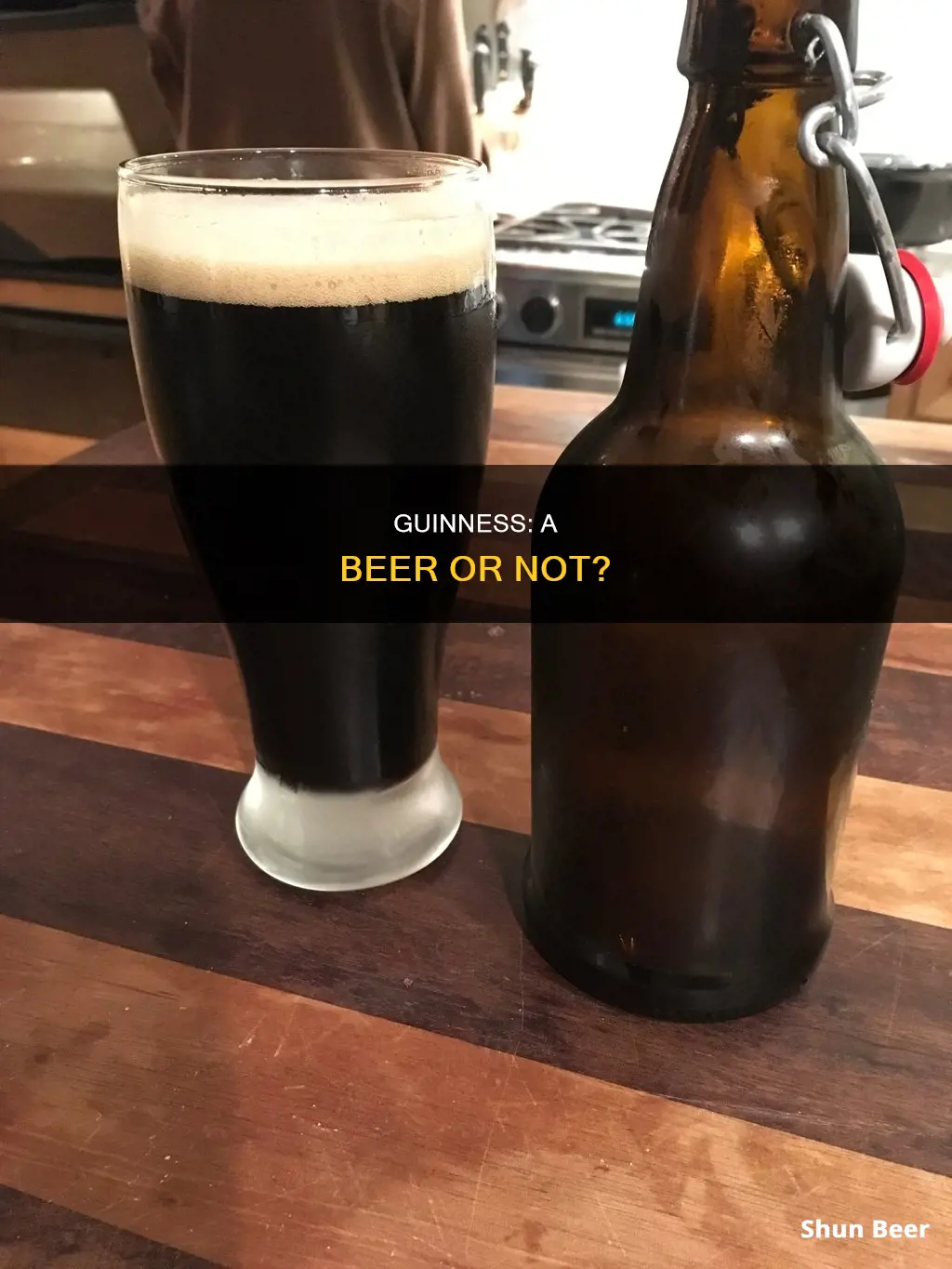
Guinness is a traditional Irish stout beer made from barley, hops, water, and a specific strain of ale yeast. It is one of the most successful beer brands worldwide, brewed in almost 50 countries and available in over 100. The beer is named after Arthur Guinness, who founded the brewery in Dublin, Ireland, in 1759.
Guinness is characterised by its deep colour and caramelised flavour, which come from barley that has been roasted but not malted. The beer is also known for its dense, creamy head, which is achieved by mixing it with nitrogen to create smaller bubbles.
The Guinness Storehouse in Dublin is the most popular tourist attraction in Ireland, attracting over 1.7 million visitors in 2019.
| Characteristics | Values |
|---|---|
| Type of beer | Stout |
| Colour | Dark ruby red |
| Flavour | Hints of roasted coffee and chocolate |
| Taste | Smoothly balanced with bitter, sweet, roasted notes |
| Calories | 125 per pint |
| Alcohol by volume | 4.1 to 4.3% |
| Country of origin | Ireland |
| Year of origin | 1759 |
| Founder | Arthur Guinness |
| Headquarters | London |
What You'll Learn

The history of Guinness
Guinness is a stout that originated in the brewery of Arthur Guinness at St. James's Gate, Dublin, Ireland, in the 18th century. On 31 December 1759, Arthur Guinness signed a 9,000-year lease for the unused brewery at a rate of £45 per annum. Ten years later, Guinness began exporting his ale, shipping six-and-a-half barrels to Great Britain.
In 1778, Arthur Guinness started selling dark beer porter, and in the 1840s, the first Guinness beers to use the term "stout" were Single Stout and Double Stout. Throughout most of its history, Guinness produced only three variations of a single beer type: porter or single stout, double or extra, and foreign stout for export. "Stout" originally referred to a beer's strength, but eventually, the meaning shifted towards body and colour.
Guinness became Ireland's largest brewery in 1838 and the world's largest by 1886, making 1.2 million barrels annually. After remaining a family business for five generations, the company changed hands several times in the latter half of the 20th century. Today, Guinness is owned by Diageo, a British multinational beverage company.
Guinness has a long history of marketing campaigns, from television advertisements to beer mats and posters. One of its most notable campaigns was created by S. H. Benson's advertising in the 1930s and 1940s, with slogans such as "Guinness for Strength" and "Guinness Is Good for You".
Guinness has continued to innovate and experiment with its beers, and in 1959, it introduced nitrogen to its brewing process, changing the texture and flavour of the beer. More recently, in 2017, Guinness made its beer suitable for vegetarians and vegans by introducing a new filtration process that avoided the use of isinglass from fish bladders.
Today, Guinness is one of the most successful alcohol brands worldwide, brewed in almost 50 countries and available in over 120. It has a significant share of the African beer market, with about 40% of worldwide total Guinness volume brewed and sold on the continent.
Guinness Beer: Does It Expire?
You may want to see also

How to pour the perfect pint
Guinness is a stout beer that originated in Dublin, Ireland, in the 18th century. It is now brewed in almost 50 countries and sold in over 120.
The "perfect pour" of Guinness is a two-part pour, a process requiring the ultimate blend of patience and precision. Here is a step-by-step guide on how to pour the perfect pint of Guinness:
- Ensure you have the right tools and conditions: a clean, dry, and cool Guinness glass (also known as a tulip glass due to its flower-like shape) and a keg of Guinness, chilled to between 3-8°C (38°F in the USA).
- The Initial Pour: Hold your glass at a 45-degree angle and aim the tap nozzle at the gold harp logo on the glass. Pour until you reach the top of the harp, then stop.
- Let the Pint Settle: Set the glass down and allow the beer to rest. This is the surge and settle phase, where the darker stout slowly sinks under the creamy, white foam. This process should take about 60-90 seconds.
- Topping Off the Pint: Once the beer has settled, fill up the rest of the glass. This time, keep the glass straight, and fill it until the foam forms a slight dome over the top.
Common mistakes to avoid when pouring Guinness include pouring too quickly, not allowing enough settling time, underfilling or overfilling the glass, and having the beer at the wrong temperature.
The perfect pour of Guinness is an art form, and mastering it is essential for bartenders to achieve the perfect head size, visual presentation, and taste.
Guinness Beer: Why This Famous Drink Is Dark Ruby
You may want to see also

Guinness and food
Guinness is a popular beer, but it's also a great ingredient to cook with. Its distinctive, rich roasted wheat flavour can add a new dimension to a dish. It's a favourite in many Irish recipes and is a perfect pairing for chocolate.
So, what foods go well with Guinness?
- Beef stew – a traditional Irish meal with tender beef, a rich broth and vegetables.
- Fish and chips – a classic comfort food, the battered or breaded fish and deep-fried chips are a perfect match for a pint of Guinness.
- Oysters – native to Ireland, oysters are a well-known aphrodisiac and go well with a pint of Guinness.
- Soda bread – an Irish staple, soda bread is made with soft wheat flour, bread soda, salt and buttermilk. Top with smoked salmon, Irish cheddar, or butter and jam.
- Short ribs – a cut of beef that is more tender and meatier than pork spare ribs.
- Shepherd's Pie – a hearty dish with a layer of vegetables and meat topped with mashed potatoes and baked.
Cooking with Guinness
Guinness is also used as an ingredient in cooking, adding depth of flavour to a range of dishes. Here are some ideas:
- Beef and Guinness pie – a classic Irish dish with a homemade pastry encasing beef, vegetables and Guinness.
- Guinness marinade – a versatile marinade with garlic, onion, shallot, Dijon mustard, and fresh herbs. Use it on steak, chicken, pork or vegetables.
- Cheddar and Guinness fondue – a simple, tasty party appetiser.
- Guinness and cheddar biscuits – the deep stout flavour complements the cheddar and lighter bread.
- Guinness brownies – the beer's natural chocolate notes intensify the flavour of the chocolate.
- Guinness chocolate pudding – a boozy, indulgent dessert.
Guinness Beer: Carbonation Secrets Revealed
You may want to see also

Guinness advertising campaigns
Guinness's advertising campaigns are known worldwide. The company's first advertising tagline, "Guinness is Good For You," was introduced in 1794, and its most recent slogan is "Made of More." Over the years, Guinness has produced striking, clever, and amusing adverts that are as memorable as the taste of the Irish stout.
In the 1930s, after a slump in sales, Guinness decided to invest in advertising and enlisted the advertising heavyweight Bensons to boost sales. Bensons created a poster campaign with slogans like "Guinness for Strength," "Guinness Makes You Strong," and "Guinness is Good for You." The artist John Gilbert designed the posters, and the campaign was a significant success, with sales skyrocketing.
In the early 1950s, the toucan was chosen as the brand's mascot, becoming as well-known as the brand's harp symbol. In 1955, Guinness produced a television advert to run alongside the toucan posters, featuring toucans descending on an army mess and stealing the soldiers' beer. This advert became one of the most well-remembered of that generation.
The "Surfer" TV advert, first shown in 1998, is another notable campaign. It features surfers waiting on the beach for the perfect wave, only to be surprised by horses rising from the water. The advert, directed by Jonathan Glazer, won 'Best ad of all time' categories and was praised for its beautiful cinematography and emotional impact.
In 2014, the "Made of More" campaign focused on the Sapeurs, the Society of Elegant Persons of Congo. The advert followed men through their working day, ending with them dressing up and attending a Sapeurs event, dancing and enjoying drinks. This campaign was lighthearted and avoided the pitiful tone often associated with adverts set in Africa.
Guinness has also utilised social media to create buzz, such as with the "#MadeOfBlack" hashtag for its Black Lager campaign, featuring short and snappy clips set to Kanye West's song, "BLKKK SKKKN HEAD."
Guinness Beer and Caffeine: What's the Connection?
You may want to see also

The different types of Guinness
Guinness is a renowned brand that arguably boasts the world's most distinctive beer. While Guinness is known primarily for its iconic Guinness Draught Stout, it has more than one beer offering. Over 20 different beers now bear the Guinness name, served in over 150 countries across the globe. Here is a list of some of the different types of Guinness:
Guinness Draught
The standard draught beer sold in kegs (but also available in widget cans and bottles) with an ABV of 4.1% to 4.3%. The Extra Cold version is served at 3.5 °C.
Guinness Foreign Extra Stout
A stronger, bitter-tasting stout with an ABV of 7.5%. The addition of extra hops and a higher ABV was initially meant to preserve the beer during long overseas excursions. It is sold in Europe, Africa, the Caribbean, Asia, and the United States, with the ABV varying by region.
Guinness Extra Stout
The precursor to every Guinness innovation, this pitch-black beer has a bittersweet flavour. It has an ABV of 5.6%.
Guinness Antwerpen
This variety was introduced in Belgium in 1944 and has been popular ever since. It is produced using a lower hop rate, resulting in a less bitter taste and a light and creamy texture. Despite the lower hop rate, it has a high ABV of 8%.
Guinness Over the Moon Milk Stout
A sweeter variety of Guinness's regular beers, brewed with added lactose and a series of specialty malts, resulting in an espresso and chocolate aroma. It has an ABV of 5.3%.
Guinness Baltimore Blonde
A combination of Irish and American brewing traditions, resulting in a refreshing, citrusy taste. The regular Mosaic hops are replaced with Citra hops to achieve this unique flavour. It has an ABV of 5%.
Guinness 200th Anniversary Export Stout
This variety celebrates 200 years of Guinness in America, bringing to life a recipe that dates back to 1817. It has a dark ruby-red colour with a slight chocolate flavour and an ABV of 6%.
Guinness Zero ABV
A non-alcoholic beverage sold in Indonesia.
Guinness Nitro Cold Brew Coffee
A surprising entry in the list of Guinness beers, this coffee-flavoured beer is outstanding according to reviewers. It has an ABV nearly identical to Guinness Draught.
Guinness Nitro IPA
An experiment by Guinness to add nitrogen to other styles of beer, in this case, an India Pale Ale. Unfortunately, this beer fell flat, as the creamy, smooth head was not a good fit for the hoppy aspect of the IPA.
Guinness West Indies Porter
A beer that is actually marketed as a "Porter", this variety imitates the 1801 Guinness variety with notes of toffee and chocolate. It has an ABV of 6%.
Guinness Hop House 13
A beer that is essentially a lager made with IPA hops, resulting in a sweeter beer with a crisp, dull-peach taste. It is likely only available in Ireland.
Vegan Alert: Guinness Beer's Surprising Ingredient
You may want to see also
Frequently asked questions
Yes, Guinness is a traditional Irish stout beer.
Guinness is made from barley, hops, water, and a specific strain of ale yeast. The deep colour and caramelised flavour come from barley that has been roasted but not malted.
Guinness has hints of roasted coffee and chocolate, with a creamy head. It is smoothly balanced with bitter, sweet, roasted notes.
Guinness should be served cold in a pint glass. The recommended serving temperature is 42 degrees Fahrenheit, but no higher than 50.
Guinness was first produced in Dublin, Ireland, in 1759 by Arthur Guinness. It is now owned by the British-based multinational alcoholic beverage maker Diageo.







